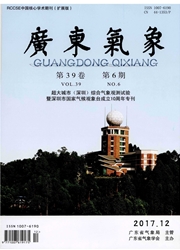

 中文摘要:
中文摘要:
基于Grapes、T639、ECMWF和JMA精细化数值模式,利用平均集成(EMN)、反误差加权集成(IEWE)、消除偏差加权集成(BRWE)法进行广州5个观测站的日极端气温集成预报研究。结果表明:(1)数值模式对最高气温的预报较为接近,其中Grapes模式的预报效果相对较优;模式对最低气温的预报普遍优于最高气温,ECMWF模式明显优于其余3种数值模式。(2)BRWE的效果最好,尤其对最高气温预报有明显改善,其24~72 h预报效果较最优的Grapes模式分别提高了27.6%、17.1%、9.9%;对最低气温的预报亦有改进,24 h预报误差较最优的ECMWF模式提高12.5%,但48~72 h的改进效果则不明显。(3)集成预报在不同季节的效果有一定差异,在夏秋、冬季节,BRWE的最高气温预报效果明显高于春季;而BRWE的最低气温预报在春、夏季节具有较高的应用价值。
 英文摘要:
英文摘要:
Base on the GRAPES, T639, ECMWF and JMA model, a daily extreme temperature ensem- ble forecast technique is developed with the observation data of five stations in Guangzhou through methods of ensemble mean (EMN), inverse error weighted ensemble (IEWE), bias-removed weighted ensemble (BRWE). Results show that : ( 1 ) the accuracies for minimum temperature of numerical models are closer, among which the GRAPES model has relatively better performance; the accuracies for minimum temperature are generally higher than those for maximum temperature, and the ECMWF model has significantly better skill than the other three numerical mode~s. (2) BI~WE is more skillful than the other two kinds of methods. It has significantly improved the maximum temperature forecast, and the improvement reach by 27.6%, 17. 1%, 9.9% within 24-72 hours compared to the best GRAPES model. BRWE also shows good improve- ment by 12.5% for the minimum temperature forecast within 24 hours compared to the best ECMWF model, however the improvement is not significant enough within 48-72 hours. (3) The multimodel ensemble tech- nique show different skill in different seasons. Between summer, autumn and winter, BRWE is significantly better for maximum temperature forecast than which in spring; while the minimum temperature forecast from BRWE has higher value in spring and summer.
 同期刊论文项目
同期刊论文项目
 同项目期刊论文
同项目期刊论文
 期刊信息
期刊信息
